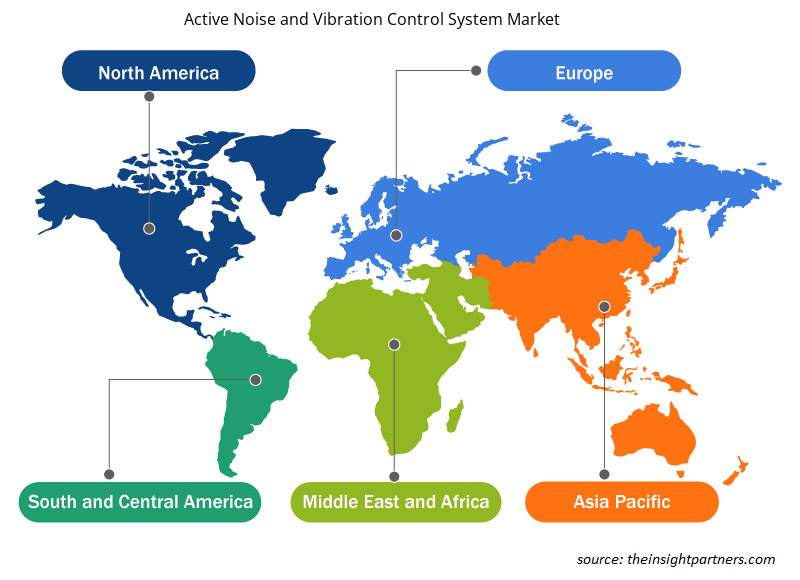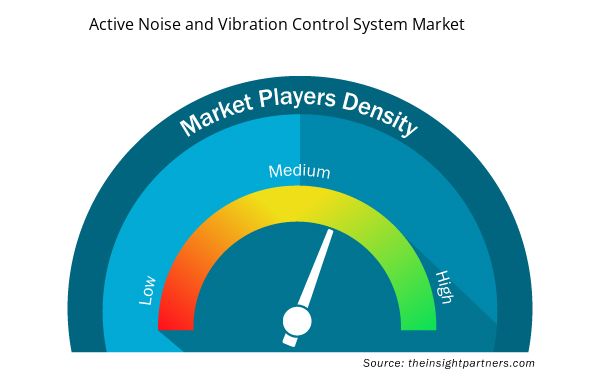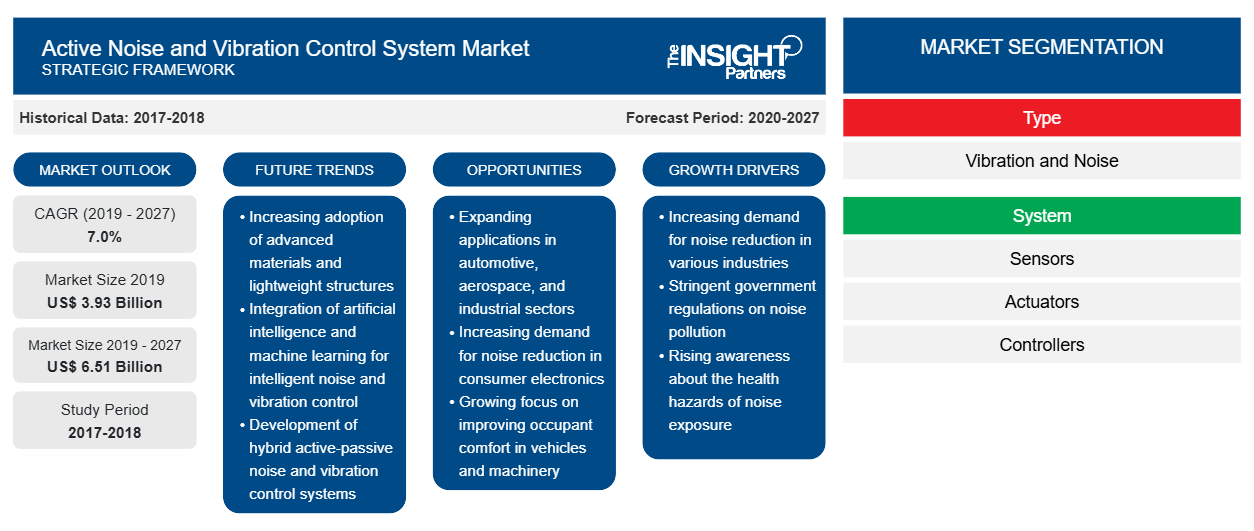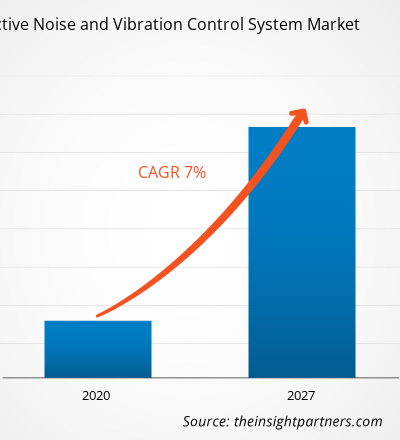En términos de ingresos, el mercado global de sistemas de control activo de ruido y vibraciones se valoró en US$ 3.925,61 millones en 2019 y se proyecta que alcance los US$ 6.505,28 millones para 2027; se espera que crezca a una CAGR del 7,0% durante el período de pronóstico de 2020 a 2027.
El mercado de sistemas de control activo de ruido y vibraciones está segmentado en cinco regiones principales: América del Norte, Europa, Asia Pacífico, Oriente Medio y África y el Área Submarina. La industria aeroespacial y de defensa en América del Norte ha madurado gracias a la existencia de un gran número de fabricantes de aeronaves y al apoyo continuo del Departamento de Defensa de los EE. UU. La demanda de tecnologías avanzadas es enorme en la región y todos los usuarios finales mencionados anteriormente conocen bien las tecnologías más nuevas. El Departamento de Defensa de los EE. UU. invierte continuamente tiempo y dinero en los avances de la flota existente y en el desarrollo de vehículos blindados terrestres de tecnología robusta, así como en buques marinos, con el objetivo de mantener una fuerza preparada para las misiones. La presencia de un gran número de fabricantes de sistemas de control activo de ruido y vibraciones en la región respalda la demanda en constante aumento, lo que impulsa el mercado de sistemas de control activo de ruido y vibraciones.
Personalice este informe según sus necesidades
Obtendrá personalización en cualquier informe, sin cargo, incluidas partes de este informe o análisis a nivel de país, paquete de datos de Excel, así como también grandes ofertas y descuentos para empresas emergentes y universidades.
- Obtenga las principales tendencias clave del mercado de este informe.Esta muestra GRATUITA incluirá análisis de datos, desde tendencias del mercado hasta estimaciones y pronósticos.
Perspectivas de mercado: mercado de sistemas de control activo de ruido y vibraciones
Aumento de la adopción de sistemas activos en la fabricación de ferrocarriles
La industria ferroviaria en todo el mundo está creciendo a un ritmo considerable a lo largo de los años, con varios avances tecnológicos en curso que reflejan viajes más seguros y cómodos. El equipo ferroviario (bogies y carros de carga) experimenta vibraciones verticales y ruido significativos, que aumentan varios tipos de riesgo durante las operaciones. Para eliminar las vibraciones y el ruido, varios fabricantes de equipos ferroviarios se centran cada vez más en la adopción de sistemas de control de ruido y vibración. El control pasivo de ruido y vibración es predominante entre los fabricantes ferroviarios, ya que estos sistemas les permiten ofrecer a sus clientes productos más seguros y cómodos. Sin embargo, la mayoría de los sistemas pasivos son sistemas hidráulicos y, en los últimos años, los fabricantes de equipos ferroviarios están haciendo hincapié en los sistemas controlados electrónicamente/eléctricamente, lo que refleja un aumento de la atracción hacia los sistemas activos de ruido y vibración. Un sistema activo con actuadores de masa inercial montados en los bogies puede controlar el ruido y las vibraciones de baja frecuencia dentro de los compartimentos. Además, los sistemas activos son generalmente sistemas electromecánicos, que se están convirtiendo en la preferencia clave entre los fabricantes de equipos ferroviarios. Se espera que este factor genere una demanda significativamente mayor de sistemas activos entre los fabricantes de equipos ferroviarios, catalizando así el mercado de sistemas de control activo de ruido y vibraciones.
Información sobre segmentos de tipo
En cuanto al tipo, el segmento de vibración dominó el mercado global de sistemas de control activo de ruido y vibración en 2019. Los sistemas de control activo de vibración son sistemas de aislamiento que responden dinámicamente a las vibraciones externas. Estos sistemas se utilizan para reducir la fricción y controlar las vibraciones en máquinas móviles o estáticas.
Información sobre segmentos del sistema
En cuanto al sistema, el segmento de actuadores dominó el mercado global de sistemas de control activo de ruido y vibración en 2019. Los actuadores están integrados en los sistemas de control activo de ruido y vibración para controlar diversas fuerzas dentro de la planta y mejorar el funcionamiento general. Estos actuadores utilizan diferentes tecnologías, como piezoeléctrica, electrodinámica y electrodinámica hidráulica.
Perspectivas del segmento industrial
En términos de industria, el segmento aeroespacial dominó el mercado global de sistemas de control activo de ruido y vibraciones en 2019. La industria aeroespacial está floreciendo a un ritmo exponencial a lo largo de los años con una gran cantidad de producciones y entregas. Los fabricantes de aeronaves y de componentes están siendo testigos de presiones significativas por parte de los usuarios finales del sector de la aviación comercial para entregar un mayor número de aeronaves.
Los actores del mercado se centran en innovaciones y desarrollos de nuevos productos integrando tecnologías y características avanzadas en sus productos para competir con los competidores.
- En 2019, Creo Dynamics anunció la adquisición de una participación mayoritaria en Faurecia, para combinar la competencia de la compañía en control activo de ruido y acústica automotriz con Faurecia y desarrollar nuevas soluciones únicas para el mercado.
- En 2019, Terma anunció que había firmado un contrato con UASF para proporcionar sistemas de audio 3D para los aviones A-10.
- En 2018, Vicoda GmbH anunció que había entregado amortiguadores de masa optimizados para pasarelas en Gante para controlar y reducir las vibraciones inducidas por los peatones y ofrece comodidad al evitar el efecto de "bloqueo".
El mercado global de sistemas de control activo de ruido y vibraciones se ha segmentado de la siguiente manera:
Perspectivas regionales del mercado de sistemas de control activo de ruido y vibraciones
Los analistas de Insight Partners explicaron en detalle las tendencias y los factores regionales que influyen en el mercado de sistemas de control activo de ruido y vibraciones durante el período de pronóstico. Esta sección también analiza los segmentos y la geografía del mercado de sistemas de control activo de ruido y vibraciones en América del Norte, Europa, Asia Pacífico, Oriente Medio y África, y América del Sur y Central.

- Obtenga datos regionales específicos para el mercado de sistemas de control activo de ruido y vibraciones
Alcance del informe de mercado sobre sistemas de control activo de ruido y vibraciones
| Atributo del informe | Detalles |
|---|---|
| Tamaño del mercado en 2019 | US$ 3.93 mil millones |
| Tamaño del mercado en 2027 | 6,51 mil millones de dólares estadounidenses |
| CAGR global (2019-2027) | 7.0% |
| Datos históricos | 2017-2018 |
| Período de pronóstico | 2020-2027 |
| Segmentos cubiertos | Por tipo
|
| Regiones y países cubiertos | América del norte
|
| Líderes del mercado y perfiles de empresas clave |
|
Densidad de actores del mercado: comprensión de su impacto en la dinámica empresarial
El mercado de sistemas de control activo de ruido y vibraciones está creciendo rápidamente, impulsado por la creciente demanda de los usuarios finales debido a factores como la evolución de las preferencias de los consumidores, los avances tecnológicos y una mayor conciencia de los beneficios del producto. A medida que aumenta la demanda, las empresas amplían sus ofertas, innovan para satisfacer las necesidades de los consumidores y aprovechan las tendencias emergentes, lo que impulsa aún más el crecimiento del mercado.
La densidad de actores del mercado se refiere a la distribución de las empresas o firmas que operan dentro de un mercado o industria en particular. Indica cuántos competidores (actores del mercado) están presentes en un espacio de mercado determinado en relación con su tamaño o valor total de mercado.
Las principales empresas que operan en el mercado de sistemas de control activo de ruido y vibraciones son:
- Compañía: Honeywell International Inc.
- Fabreeka Internacional Inc.
- Fabricante: Moog Inc.
- Corporación Parker Hannifin
- Faurecia Creo AB
Descargo de responsabilidad : Las empresas enumeradas anteriormente no están clasificadas en ningún orden particular.

- Obtenga una descripción general de los principales actores clave del mercado de sistemas de control activo de ruido y vibraciones
Mercado de sistemas de control activo de ruido y vibraciones: por tipo
- Vibración
- Ruido
Mercado de sistemas de control activo de ruido y vibraciones: por sistema
- Sensores
- Actuadores
- Controladores
- Amortiguadores
Mercado de sistemas de control activo de ruido y vibraciones: por sistema
- Aeroespacial
- Ala fija
- Ala rotatoria
- Defensa
- Vehículo terrestre
- Buques de guerra
- Ferrocarril
- Industrias generales
- Fabricación
- Energía y potencia
Mercado de sistemas de control activo de ruido y vibraciones: por sistema
- Sensores
- Actuadores
- Controladores
- Amortiguadores
Mercado de sistemas de control activo de ruido y vibraciones por región
- América del norte
- A NOSOTROS
- Canadá
- México
- Europa
- Francia
- Alemania
- Italia
- Reino Unido
- Rusia
- Resto de Europa
- Asia Pacífico (APAC)
- Porcelana
- India
- Corea del Sur
- Japón
- Australia
- Resto de APAC
- Oriente Medio y África (MEA)
- Sudáfrica
- Arabia Saudita
- Emiratos Árabes Unidos
- Resto de MEA
- América del Sur (SAM)
- Brasil
- Resto de SAM
Mercado de sistemas de control activo de ruido y vibraciones: perfiles de empresas
- FÁBREKA
- Compañía: Honeywell International Inc.
- Hutchinson
- Terma A/S
- Fabricante: Moog Inc.
- Parker Hannifin
- Faurecia Creo AB
- Supershock
- Trelleborg AB
- VICODA GmbH
- Análisis histórico (2 años), año base, pronóstico (7 años) con CAGR
- Análisis PEST y FODA
- Tamaño del mercado Valor/volumen: global, regional, nacional
- Industria y panorama competitivo
- Conjunto de datos de Excel



Report Coverage
Revenue forecast, Company Analysis, Industry landscape, Growth factors, and Trends

Segment Covered
This text is related
to segments covered.

Regional Scope
North America, Europe, Asia Pacific, Middle East & Africa, South & Central America

Country Scope
This text is related
to country scope.
Preguntas frecuentes
The aerospace and defense industry in North America is matured with the existence of a large number of aircraft manufacturers, and continuous support from the US DoD. The demand for advanced technologies is tremendous in the region, with all the end users mentioned above are well aware of newer technologies. The US DoD continuously invests time and amounts towards the advancements of existing fleet and development of robust technology ground armored vehicles as well as marine vessel with an objective to maintain a mission-ready force. The presence of a large number of active noise and vibration control system manufacturers in the region is supporting the ever-rising demand, which is thereby boosting the active noise and vibration control system market.
The actuators segment capture maximum share in active noise and vibration control system market. The actuators in the active vibration control system are used to reduce vibrations produced in the machines; however, they are also used as shakers in the active isolation system. These actuators are connected to the sensors and are available in the same number, orientation, and location as that of the sensors The actuators reduce the incoming vibrations, thereby permitting the load on the intact system.
The aviation industry is maturing at a rapid rate over the years, recording a significant number of production and deliveries of aircraft (commercial and military) fleet (fixed wing and rotary wing). However, the aircraft manufacturers are heavily challenged on decreasing the overall weight of any aircraft. The active noise and vibration control systems offer significant weight reduction capability as compared with its passive counterparts. This factor is increasing the interest among the end users to adopt the technology.
Trends and growth analysis reports related to Aerospace and Defense : READ MORE..
The List of Companies - Active Noise and Vibration Control System Market
- Honeywell International Inc.
- Fabreeka International Inc.
- Moog Inc.
- Parker Hannifin Corporation
- Faurecia Creo AB
- Supashock Advanced Technologies
- Trellborg AB
- Hutchinson
- Terma A/S
- Vicoda GmbH
The Insight Partners performs research in 4 major stages: Data Collection & Secondary Research, Primary Research, Data Analysis and Data Triangulation & Final Review.
- Data Collection and Secondary Research:
As a market research and consulting firm operating from a decade, we have published and advised several client across the globe. First step for any study will start with an assessment of currently available data and insights from existing reports. Further, historical and current market information is collected from Investor Presentations, Annual Reports, SEC Filings, etc., and other information related to company’s performance and market positioning are gathered from Paid Databases (Factiva, Hoovers, and Reuters) and various other publications available in public domain.
Several associations trade associates, technical forums, institutes, societies and organization are accessed to gain technical as well as market related insights through their publications such as research papers, blogs and press releases related to the studies are referred to get cues about the market. Further, white papers, journals, magazines, and other news articles published in last 3 years are scrutinized and analyzed to understand the current market trends.
- Primary Research:
The primarily interview analysis comprise of data obtained from industry participants interview and answers to survey questions gathered by in-house primary team.
For primary research, interviews are conducted with industry experts/CEOs/Marketing Managers/VPs/Subject Matter Experts from both demand and supply side to get a 360-degree view of the market. The primary team conducts several interviews based on the complexity of the markets to understand the various market trends and dynamics which makes research more credible and precise.
A typical research interview fulfils the following functions:
- Provides first-hand information on the market size, market trends, growth trends, competitive landscape, and outlook
- Validates and strengthens in-house secondary research findings
- Develops the analysis team’s expertise and market understanding
Primary research involves email interactions and telephone interviews for each market, category, segment, and sub-segment across geographies. The participants who typically take part in such a process include, but are not limited to:
- Industry participants: VPs, business development managers, market intelligence managers and national sales managers
- Outside experts: Valuation experts, research analysts and key opinion leaders specializing in the electronics and semiconductor industry.
Below is the breakup of our primary respondents by company, designation, and region:

Once we receive the confirmation from primary research sources or primary respondents, we finalize the base year market estimation and forecast the data as per the macroeconomic and microeconomic factors assessed during data collection.
- Data Analysis:
Once data is validated through both secondary as well as primary respondents, we finalize the market estimations by hypothesis formulation and factor analysis at regional and country level.
- Macro-Economic Factor Analysis:
We analyse macroeconomic indicators such the gross domestic product (GDP), increase in the demand for goods and services across industries, technological advancement, regional economic growth, governmental policies, the influence of COVID-19, PEST analysis, and other aspects. This analysis aids in setting benchmarks for various nations/regions and approximating market splits. Additionally, the general trend of the aforementioned components aid in determining the market's development possibilities.
- Country Level Data:
Various factors that are especially aligned to the country are taken into account to determine the market size for a certain area and country, including the presence of vendors, such as headquarters and offices, the country's GDP, demand patterns, and industry growth. To comprehend the market dynamics for the nation, a number of growth variables, inhibitors, application areas, and current market trends are researched. The aforementioned elements aid in determining the country's overall market's growth potential.
- Company Profile:
The “Table of Contents” is formulated by listing and analyzing more than 25 - 30 companies operating in the market ecosystem across geographies. However, we profile only 10 companies as a standard practice in our syndicate reports. These 10 companies comprise leading, emerging, and regional players. Nonetheless, our analysis is not restricted to the 10 listed companies, we also analyze other companies present in the market to develop a holistic view and understand the prevailing trends. The “Company Profiles” section in the report covers key facts, business description, products & services, financial information, SWOT analysis, and key developments. The financial information presented is extracted from the annual reports and official documents of the publicly listed companies. Upon collecting the information for the sections of respective companies, we verify them via various primary sources and then compile the data in respective company profiles. The company level information helps us in deriving the base number as well as in forecasting the market size.
- Developing Base Number:
Aggregation of sales statistics (2020-2022) and macro-economic factor, and other secondary and primary research insights are utilized to arrive at base number and related market shares for 2022. The data gaps are identified in this step and relevant market data is analyzed, collected from paid primary interviews or databases. On finalizing the base year market size, forecasts are developed on the basis of macro-economic, industry and market growth factors and company level analysis.
- Data Triangulation and Final Review:
The market findings and base year market size calculations are validated from supply as well as demand side. Demand side validations are based on macro-economic factor analysis and benchmarks for respective regions and countries. In case of supply side validations, revenues of major companies are estimated (in case not available) based on industry benchmark, approximate number of employees, product portfolio, and primary interviews revenues are gathered. Further revenue from target product/service segment is assessed to avoid overshooting of market statistics. In case of heavy deviations between supply and demand side values, all thes steps are repeated to achieve synchronization.
We follow an iterative model, wherein we share our research findings with Subject Matter Experts (SME’s) and Key Opinion Leaders (KOLs) until consensus view of the market is not formulated – this model negates any drastic deviation in the opinions of experts. Only validated and universally acceptable research findings are quoted in our reports.
We have important check points that we use to validate our research findings – which we call – data triangulation, where we validate the information, we generate from secondary sources with primary interviews and then we re-validate with our internal data bases and Subject matter experts. This comprehensive model enables us to deliver high quality, reliable data in shortest possible time.


 Obtenga una muestra gratuita de este informe
Obtenga una muestra gratuita de este informe